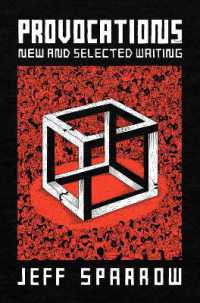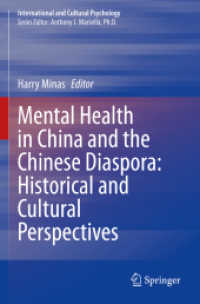- ホーム
- > 洋書
- > 英文書
- > Philosophy
Full Description
The artwork of Maria Bussmann, a trained academic German philosopher and a significant visual artist, provides an ideal test case for a philosophical study of visual art. Bussmann has internalized the relationship between art and philosophy. In this exploration of the history of German aesthetics through Bussmann's work, David Carrier places the philosophical tradition in the context of contemporary visual culture.
Each chapter focuses on the arguments of a major philosopher whose concerns Bussmann has dealt with as an artist: Kant, Hegel, Merleau-Ponty, Wittgenstein and Arendt. Offering comparative accounts of artists and philosophers whose work is of especial relevance, Carrier shows how Bussmann responds visually to writings of philosophers in art that has an elusive but essential relationship to theorizing. Tackling the question of whether philosophical subjects can be presented visually, Carrier offers a fresh perspective on the German idealist position through the visual art of 21st-century artist steeped in the tradition and continually challenging it through her work.
Contents
Personal Preface
Introduction: Philosophy as a Subject for Visual Art
1. Identity/Metamorphosis/Translation
2. An Introduction to Maria Bussmann's Translations
3. Are Translations of Philosophy into Visual Art Possible?
4. Ludwig Wittgenstein, Tractatus Logico-Philosophicus
5. Maurice Merleau-Ponty, The Visible and the Invisible
6. Hannah Arendt
7. Lawrence Carroll and Maria Bussmann
8. Illustrations, Graphic Novels, Diagrams
9. An Art History Made by Bussmann
10. the Composition and Interpretation of Bussmann's Art
Conclusion: The Contribution of Bussmann's Art to Philosophical Aesthetics
Maria Bussmann: Selected Solo and Group Exhibitions
Maria Bussmann: Selected Public and Private Collections
Bibliography
Index







